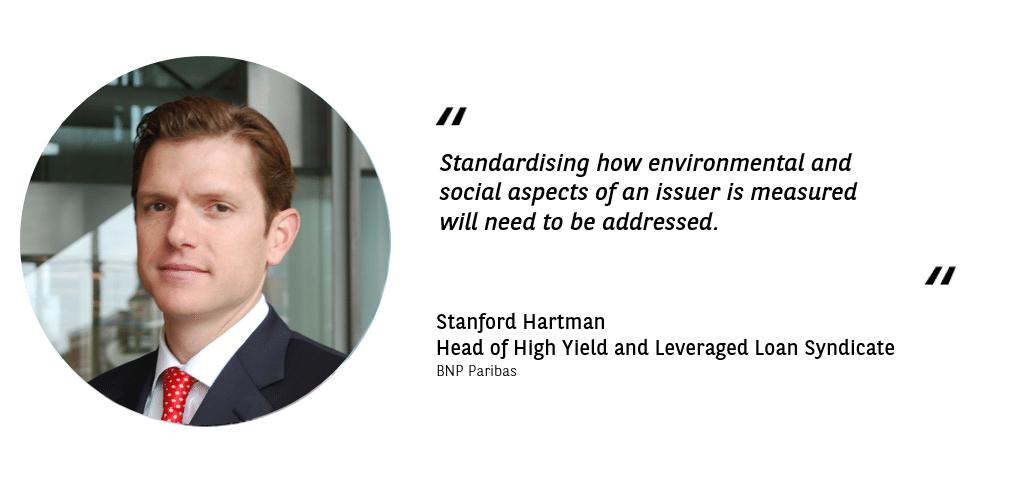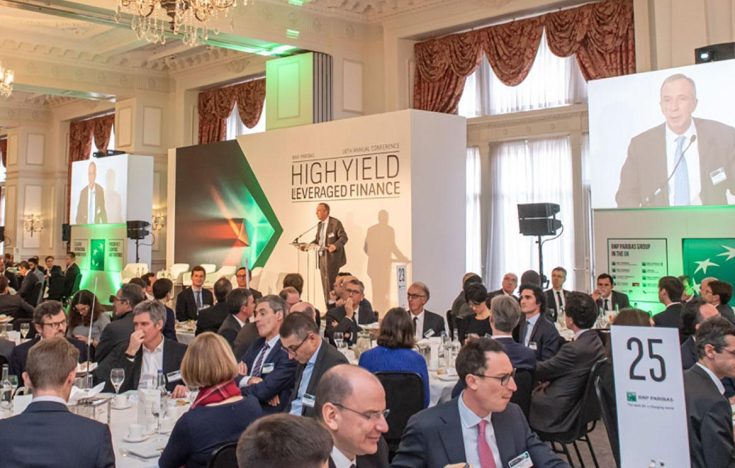Amid talk of bulls, bears, credit
cycles, all-time low yields and geopolitical risk, many among the more than
1,000 market leaders who gathered at BNP Paribas’ High Yield and
Leveraged Finance Conference 2020 had reason to be
optimistic. Few at the event, now in its 16th year, disagreed that market conditions were benign compared to 12
months before: the macroeconomic environment is supportive, volumes in the
collateralised loan obligation (CLO) market are healthy and private equity
firms have the resources to invest in the right deals (see green box).
“The overall tone coming from the
event was one of the most bullish we have seen in quite some time,” says Stanford
Hartman, Head of High Yield and Leveraged Loan Syndicate at BNP Paribas. “There
was a consensus view that the leveraged capital markets are in great shape at
the start of 2020, with few noticeable headwinds.”
One topic that was prevalent in almost all
the panel discussions, however, was ESG investing. This may not be so
surprising: corporate borrowers and investors alike are in a race to find the right
path forward in their efforts to embed environmental, social and governance
factors into the investment process.
| Leveraged finance: outlook for 2020 Following a strong 2019 – which saw high yield volumes up 17% despite lower acquisition-related flows, solid returns in both high yield and loans, and almost $30 billion of supply in the CLO space – leveraged finance appears to be on a healthy footing. The enduring growth of private equity will continue to fuel the growth and development of the leveraged capital markets in 2020 and beyond. Here are three key takeaways:
|
Driven by a generational shift in attitudes and an increasing awareness of environmental risk among policymakers, an ESG framework increasingly prevalent in investment-grade credit has not yet, however, penetrated the leveraged capital markets world to the same degree.
But ESG is a tidal wave that is about to come ashore and all market practitioners – in private markets as well as public, and in high yield as well as investment grade – will have to swim in it.

The ESG opportunity
But what does ESG entail, practically speaking? There is little dispute that there is a major shift underway from the shareholder model to a stakeholder one. One panellist on the ESG panel at the conference remarked that while ethics drove the movement, recognition and regulation were now raising expectations of financial impact: markets are pricing in the erstwhile negative externalities of polluting. The EU Taxonomy on sustainable capital markets is a key example of regulatory efforts to move towards standardisation. All this could entail a radical reallocation of capital in the global economy.For investors, there is an increasing need for the corporates they are financing to have an ESG-friendly framework – for instance, a carbon policy. The absence of an ESG framework in the future may mean exclusion from index funds – and therefore could have an impact on a company’s cost of capital.

In his January 2020 letter to company CEOs, BlackRock’s Larry Fink reaffirmed his push for companies to step up their efforts, stating his belief that greater climate awareness meant “we are on the edge of a fundamental reshaping of finance” – no small claim from the CEO of the world’s largest asset manager.
The High Yield (vs. IG) risk premium: lower

While there is agreement on the principle, the greater challenge is where to find the common ground on what ESG-friendly investing should look like. Different interpretations of what constitutes environmental-, social- or governance-driven investment mean different views on the relative merits of each metric. This entails trade-offs. (Can investors agree on how to assess, say, a coal-mining company with exceptional social and governance credentials?)
What does ESG mean for the high yield and leveraged markets?
While ESG had its own panel discussions at the conference, it also emerged as a major theme in the CLO and private equity panels. Some remarked on the fundamentally different
dynamics between the debt and equity investing worlds: equity investors have the
capacity to directly change how companies are run. This could be significant in
terms of realising ESG objectives. The macroeconomic environment is supportive, CLO volumes are healthy and private equity firms have the resources to invest in the right deals.
One CLO panellist raised concerns around
the price differentials of ESG versus non-ESG underlying assets, which will
remain unknown without a “framework that is genuine and legitimate and scalable.”
Furthermore, there is the challenge of
ESG reporting for smaller privately-owned companies. While it will be the
larger companies that have the capacity to report, high yield investors will
not want to hold only the larger credits just because that is where the reporting is
happening.
For BNP Paribas’ Stanford Hartman, ESG
in leveraged finance is something all market participants are grappling with as
the market attempts to work towards a standardised framework to efficiently report, track
and value it. “While governance has
always been a key part of the investment process, standardising how environmental
and social aspects of an issuer is measured has presented a great challenge”, he explains. “It is something the industry will need to address.”
Private vs. public
The upbeat market environment at the beginning of 2020 is an excellent opportunity for high yield and leveraged finance as a whole – and an excellent opportunity for ESG. But if ESG is the primary mechanism for incentivising good behaviour for companies in the public markets, it remains to be determined how this will interact with the same objectives in the private markets, where incentive structures, time horizons and reporting obligations may differ.Moreover, market practitioners still have many questions around the reliability of ESG data – not least in measuring impact. As the debates at BNP Paribas’ conference confirmed, there remains much work to do before the market can settle on a common standard. Ultimately, if good ESG credentials mean good business credentials, borrowers and investors will want to be able to show a causal link between environmental and social impact, on the one hand, and economic performance, on the other.
In an arena where a consensus is to be found, finding the right path forward, where ESG can be measured in a comparable and comprehensive way, is the challenge – and the opportunity.

